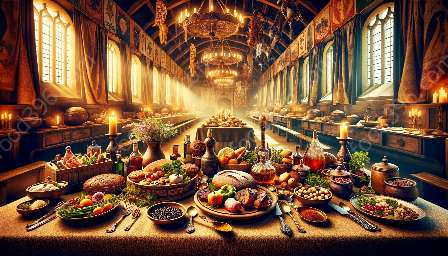Medieval cuisine offers a fascinating glimpse into the culinary history of the Middle Ages. From the ingredients used to the cooking techniques employed, this era's food culture was rich and varied. In this topic cluster, we'll delve into the world of medieval cuisine, exploring its ingredients, cooking techniques, and its impact on culinary history.
1. Ingredients in Medieval Cuisine
Medieval cuisine relied heavily on locally available ingredients and seasonal produce. The diet of people during this time was largely dependent on the region in which they lived, as well as their socioeconomic status. Common ingredients included:
- Grains: Wheat, barley, rye, and oats were staple grains used to make bread, porridge, and ale.
- Meat: The consumption of meat, particularly pork, beef, and mutton, was common among the nobility and wealthier classes, while the peasantry relied on poultry and game.
- Vegetables: Root vegetables such as turnips, carrots, and onions, as well as leafy greens like cabbage and leeks, were commonly used in medieval dishes.
- Fruits: Apples, pears, berries, and dried fruits were popular choices in both sweet and savory dishes.
- Herbs and Spices: Common herbs included parsley, thyme, and sage, while spices such as cinnamon, ginger, and saffron were prized commodities, often used to mask the flavors of preserved meats.
- Dairy: Cheese, butter, and milk, primarily from cows and goats, were essential in medieval cooking.
- Fish: Freshwater and saltwater fish, as well as seafood like oysters and mussels, were consumed along coastal regions and near waterways.
The availability of ingredients varied across different regions, and trade routes played a significant role in introducing new and exotic items to medieval kitchens. In addition to the ingredients listed above, medieval cuisine also featured the use of honey, vinegar, and nuts, as well as the utilization of diverse cooking fats such as lard, suet, and olive oil.
2. Cooking Techniques in Medieval Cuisine
Medieval cooking techniques were heavily influenced by the tools and technologies available during that time. The following were some of the prominent methods employed in preparing medieval dishes:
- Open-fire Cooking: Most cooking during the medieval period took place over open flames, whether in hearths, fire pits, or outdoor ovens. Skewering, roasting, and grilling were common techniques for cooking meat, while pots and cauldrons were used for simmering stews and soups.
- Baking: Baking was a crucial part of medieval cooking, with bread being a dietary staple. Bakeries in towns and villages produced various types of bread, and ovens were also used for making pies, tarts, and pastries.
- Preservation Methods: Given the lack of refrigeration, medieval cooks relied on preservation methods such as salting, smoking, pickling, and drying to extend the shelf life of food items, especially meat and fish.
- Seasoning and Flavoring: Herbs, spices, and condiments were used not only for flavor enhancement but also for their perceived medicinal properties. They were often ground into powders, infused into liquids, or incorporated into sauces and marinades.
- Alchemical Practices: While not as widely known as other techniques, medieval cookery involved alchemical practices such as distillation and extraction, especially in the creation of medicinal tinctures, flavored waters, and perfumed oils.
Throughout the medieval period, cooking techniques evolved in response to advancements in culinary implements, such as the introduction of metal cookware, as well as the influence of trade and cultural exchanges, which brought new cooking methods and flavors to different regions.
3. Impact on Culinary History
The ingredients and cooking techniques of medieval cuisine have left a lasting impact on culinary history, influencing subsequent culinary traditions and food customs. The use of local and seasonal ingredients, as well as the emphasis on preservation methods, laid the groundwork for the development of regional gastronomies and traditional dishes.
Medieval cooking methods also contributed to the creation of iconic dishes that continue to be celebrated today, such as roasts, stews, and meat pies. The integration of herbs, spices, and flavorings into medieval recipes set the stage for the exploration and cultivation of global spices and seasonings during the Age of Discovery.
Furthermore, the fusion of culinary practices from diverse cultures, as seen in the cooking techniques of the medieval period, exemplifies the interconnectedness of culinary history and the exchange of culinary knowledge across borders. This cross-pollination of food traditions has shaped not only the evolution of specific cuisines but also the broader narrative of human migration and cultural exchange.
By understanding the ingredients and cooking techniques of medieval cuisine, we gain insight into the socioeconomic, environmental, and cultural factors that shaped the gastronomic landscape of the Middle Ages and set the stage for the rich and diverse culinary heritage we experience today.
In conclusion, exploring the ingredients and cooking techniques of medieval cuisine provides a window into a bygone era, offering a deeper appreciation for the historical, cultural, and gastronomic significance of this period in culinary history.

